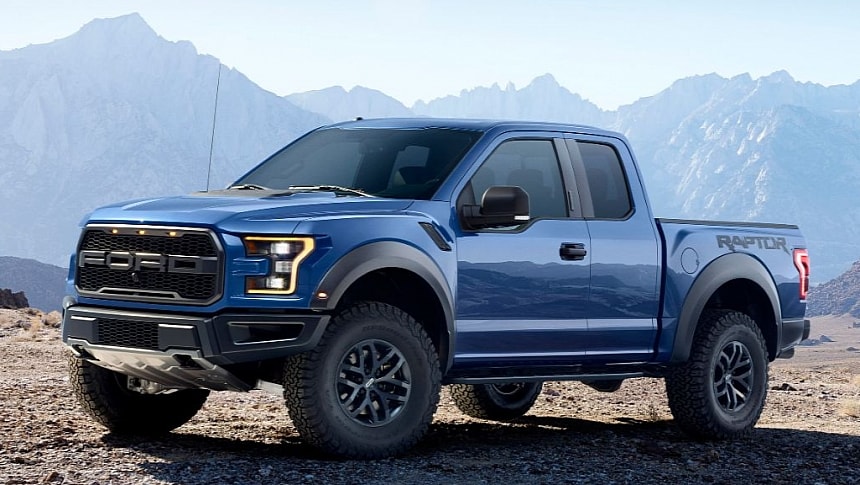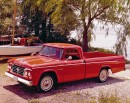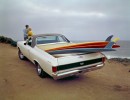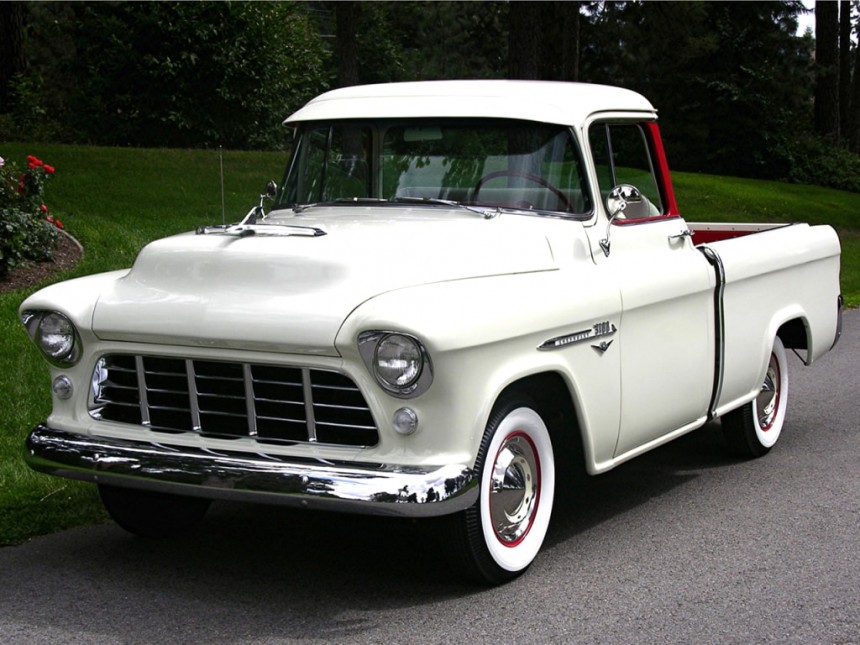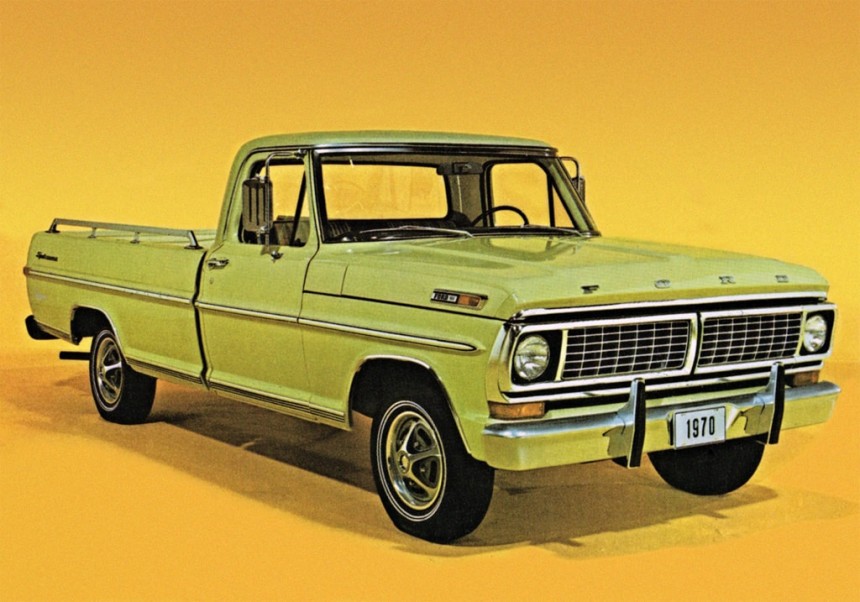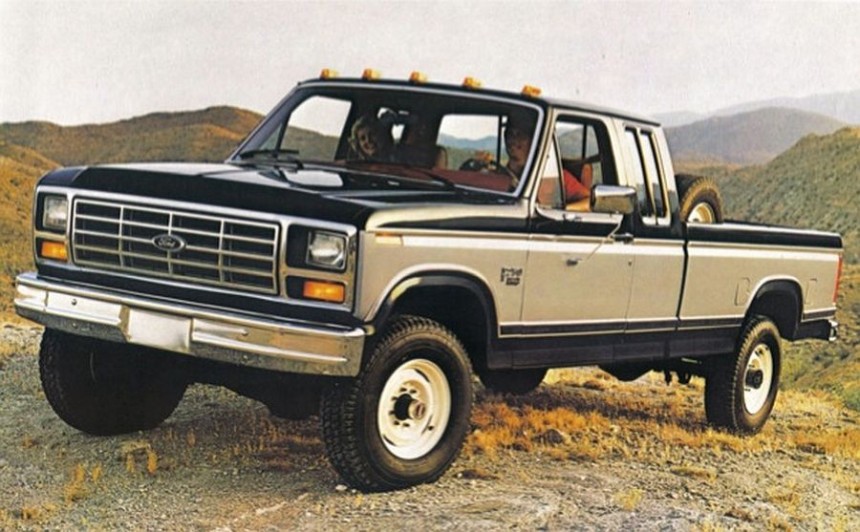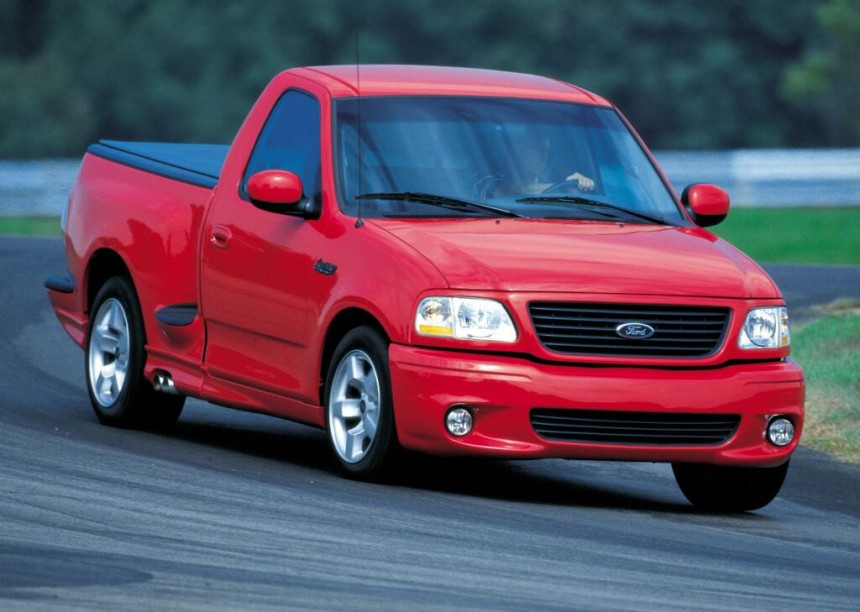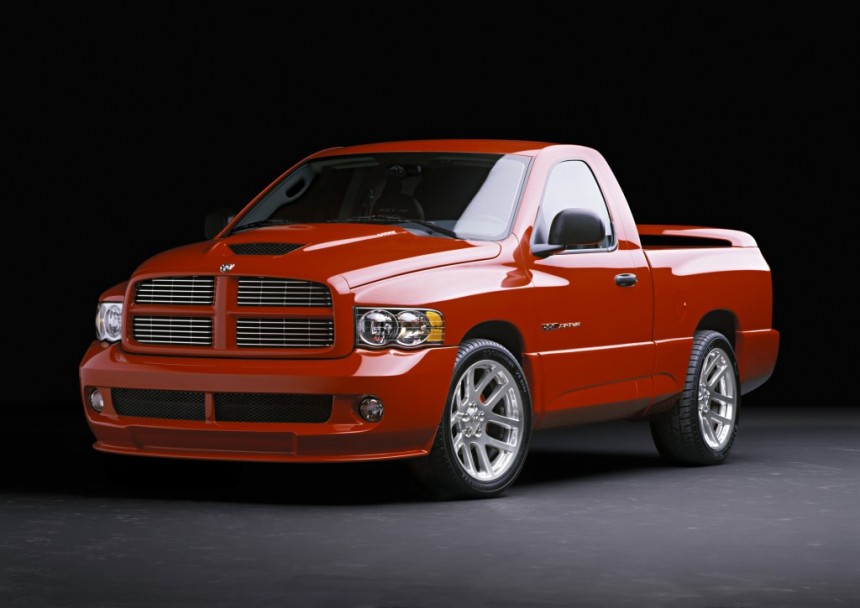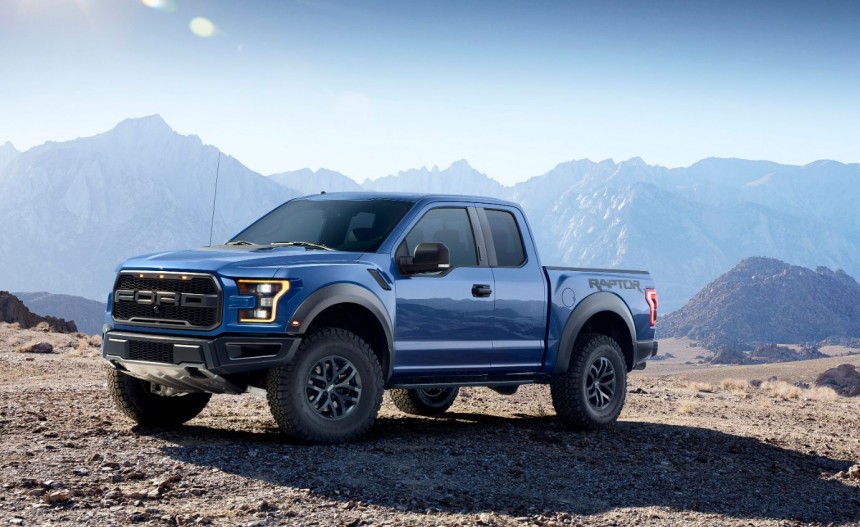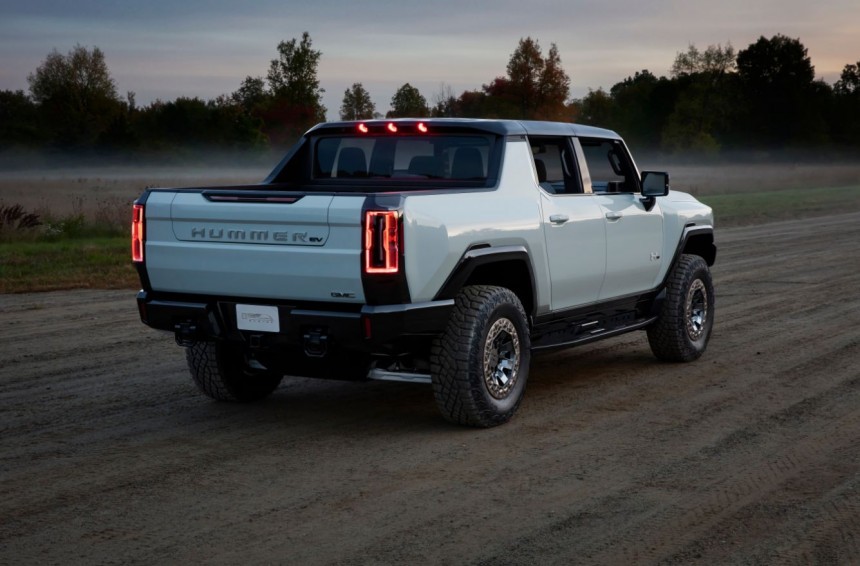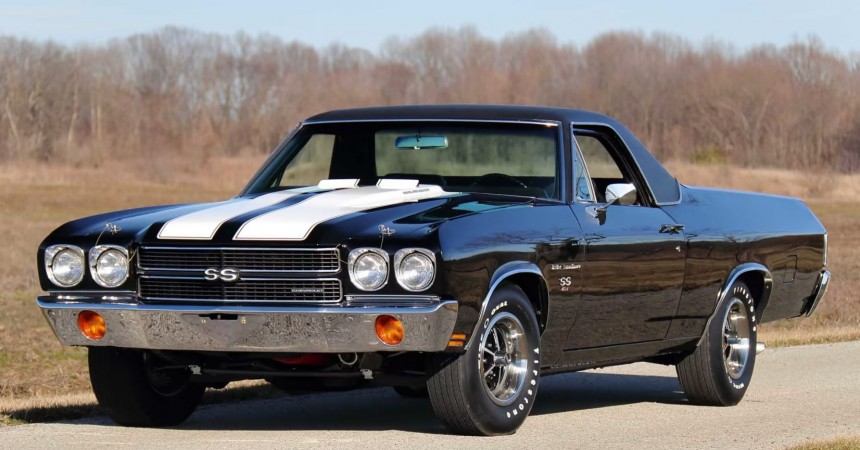Just like the passenger car, the pickup truck is more than 100 years old as of 2024. And in addition to having become more capable and reliable, the pickup truck is now significantly faster and more powerful than its early iterations. And nothing provides better insight into how things have evolved than a list of the most powerful production trucks by decade.
I opted to kick things off with the 1950s because that's when automakers started seeing pickup trucks as more than just rugged workhorses. It was also around this time that the last independent automakers went into the history books, and the Big Three became the only significant manufacturers in the US.
The 1950s was a pivotal era for the American automobile industry. Thanks to the post-WW2 economic boom, the market was flooded with new technology, and production increased dramatically to meet an unprecedented demand.
The V8 engine had become commonplace and horsepower ratings were getting increasingly higher. In 1955, Chrysler unleashed the first production car with 300 horsepower, the C-300. Pickup trucks were still seen as utilitarian rigs, but they were getting more car-like features and peppier V8s.
While they weren't quite as powerful as their automobile counterparts, pickup trucks stepped into 200-horsepower territory. It happend in the second half of the decade thanks to haulers like the Dodge C-Series and the Chevrolet Task Force.
Introduced in 1954, the C-Series got the 315-cubic-inch (5.2-liter) Red Ram V8 on the options list in 1957. It was rated at 204 horsepower. Two years later, it was replaced with the new A-type 318-cubic-inch (5.2-liter) V8, good for exactly 200 horsepower.
Chevrolet took things up a notch with the Task Force. The then-new lineup also included the Cameo, the first American truck with car-like features. The Cameo sported passenger-car styling, two-tone paint, power steering, and a relatively luxurious cabin.
The Cameo was also available with an array of V8 engines, including a four-barrel 283-cubic-inch (4.6-liter) unit rated at 220 horsepower and 295 pound-feet (400 Nm) of torque. It remained the most powerful pickup until the mid-1960s.
The 1960s marked the beginning of the muscle car craze. Carmakers began dropping big engines in midsize cars, creating a niche of V8-powered high-performance rigs. Some of these mills eventually found their way into other segments, including full-size cars and trucks. Toward the end of the decade, some pickup trucks were available with more than 300 horsepower.
But the decade's most potent hauler is actually a short-lived rig from 1964. I'm talking about the Dodge D-100 Street Wedge. As the name suggests, this truck was fitted with the street-spec version of the iconic Max Wedge racing engine. The 426-cubic-inch (7.0-liter) unit, not to be confused with the HEMI, sent 365 horsepower to the rear wheels.
The mill also turned the D-100 into the quickest pickup of its era. The Mopar needed less than eight seconds to hit 60 mph (97 kph) from a standing start and covered the quarter-mile in less than 16 clicks.
The D-100 Street Wedge was an expensive truck, so customers didn't rush to order one. Discontinued after only a year on the market, it was built in about 50 units. This rare pickup was actually the most potent truck of the golden muscle car era, as no other hauler from the Big Three surpassed the 365-horsepower mark without aftermarket intervention.
With muscle cars on their way out due to new emissions and fuel economy regulations, pickup trucks did not become more powerful in the 1970s. However, a couple of optional V8 engines kept them in 250-horsepower territory in the first half of the decade. Chevrolet offered a 250-horsepower 350-cubic-inch V8 in the C/K, while Ford's iconic 390-cubic-inch (6.5-liter) FE unit delivered 255 horsepower in the fifth-generation F-Series.
Although it wasn't the most potent truck of the decade, the Dodge Li'l Red Express is also worth mentioning. Born in 1978, when muscle cars were a thing of the past, the Li'l Red Express packed a 360-cubic-inch (5.9-liter) Interceptor-spec V8 good for 225 horsepower.
It was notably more than the contemporary F-Series and C/K and on par with the Chevrolet Corvette. In fact, the truck was a tad quicker than the sports car in a 0-to-100 mph (161 kph) acceleration test by Car and Driver magazine. It was America's fastest production vehicle that year and the most potent pickup of the Malaise Era.
The 1980s brought many changes to the US automotive market. This era saw a massive market revitalization due to falling oil prices, the arrival of the minivan, and the widespread use of front-wheel-drive platforms. Cars also became a bit more potent, signaling the end of the Malaise Era.
Trucks were becoming more all-purpose and less work-oriented, but output did not increase dramatically compared to the 1970s. While most truck didn't hit the 200-horsepower mark, some range-topping engines delivered solid oomph.
The 454-cubic-inch V8 Chevrolet had launched in the 1970s and remained available in the C/K through 1991. It was rated at 230 horsepower for nearly two decades. The Jeep Gladiator, which had been renamed the J-Series, was almost as powerful thanks to a 401-cubic-inch V8 good for 225 horsepower.
However, Ford had the most powerful mill in the 1980s. I'm talking about the 385-series 460-cubic-inch (7.5-liter) V8. Offered from 1983 to 1986, his behemoth generated 245 horsepower and 380 pound-feet (515 Nm) of twist. The unit wasn't available in the F-150, though; only the F-250 and F-350 heavy-duty rigs had it on the options list.
The 1990s saw the pickup truck morph into a lifestyle vehicle. By the end of the decade, Japanese haulers were being assembled in Texas. This decade also brought the revival of the high-performance car. And with it, a new beginning for the pickup truck market.
Chevrolet kickstarted the modern performance truck era with the 454 SS in 1990. However, this beefed-up pickup wasn't notably more powerful than the F-250 of the 1980s at 255 horsepower. In 1991, however, GMC jumped on the bandwagon with the Syclone. And unlike the 454 SS, the Syclone packed a turbocharged V6 engine good for 280 horsepower. Ford also joined the new segment with the SVT Lightning in 1993, but it was far from impressive at 240 horsepower.
Unlike its rivals, Dodge did not create high-performance trucks in the 1990s, but it became the first company to offer a 300-horsepower unit since the golden muscle car era. I'm talking about the 8.0-liter Magnum V10. Based on the 5.2-liter Magnum V8, this massive lump debuted in 1994 in the Ram 2500 and 3500 heavy-duty trucks. It was rated at 300 horsepower and 450 pound-feet (610 Nm) of torque.
In 1999, however, Ford introduced a new SVT Lightning truck with significantly more oomph. Now powered by a supercharged 5.4-liter V8, the beefed-up F-150 delivered an impressive 360 horsepower and 440 pound-feet (597 Nm) of torque.
The SVT Lightning became more potent in 2001 when an update increased output to 380 horsepower. However, the high-performance F-150 was discontinued without a successor in 2004. Neither Ford nor Chevrolet developed a more powerful truck until the end of the decade, but Dodge took over with a Ram pickup that set a new output record.
In 2004, just as the SVT Lightning was exiting the market, Dodge unleashed the Ram SRT-10. The Ram 1500 was already plenty powerful thanks to the range-topping 5.7-liter HEMI rated at 345 horsepower, but the SRT-10 took things up a notch. One that accounted for more than 150 horsepower.
The most outlanding pickup developed at the time, the SRT-10 was essentially a Ram 1500 with a Dodge Viper heart. It wasn't the first pickup with a V10 engine (Dodge had done it in 1994), but the massive 8.3-liter mill shared with the sports car generated a whopping 500 horsepower.
Paired with either a six-speed manual or a four-speed automatic, the V10 enabled the truck to charge from 0 to 60 mph in just 4.9 seconds on its way to a top speed of 154 mph (248 kph). The latter figure made the SRT-10 the world's fastest production truck. The SRT-10 remained in production through 2006, selling 10,046 units.
2010 saw the arrival of the F-150 Raptor, Ford's spiritual successor to the SVT Lightning. The truck came standard with a 5.4-liter V8 good for 320 horsepower, but the optional 6.2-liter unit sent 411 horses to the wheels. The Raptor became the most powerful Ford pickup to date, but it was nowhere near as potent as the Ram SRT-10.
The Raptor became more potent toward the end of the decade. However, the second-gen hauler dropped the V8 engine in favor of a twin-turbo V6. The 3.5-liter EcoBoost, essentially a debuted version of the V6 used in the Ford GT, turned the Raptor into a 450-horsepower rig.
In the absence of high-performance competition from Chevrolet and Ram Truck, the second-gen Raptor remained the most powerful pickup truck of the decade. However, the Chevrolet Silverado HD came pretty close thanks to a 6.6-liter Duramax V8 rated at 455 horsepower. The diesel provided notably more torque at 910 pound-feet (1,234 Nm).
We're only four years into this decade and things have already gotten pretty wild. And it's mostly due to the rise of all-electric powertrains. Sure, the Ram 1500 TRX is pretty darn impressive at 702 horsepower, but some battery-powered rigs produce much more than that.
The Tesla Cybertruck is obviously the first that comes to mind. This unconventionally shaped hauler cranks out 845 horsepower in Cyberbeast trim, which comes with a tri-motor setup. And if this power figure sounds impressive, how about 10,296 pound-feet (13,960 Nm) of torque?
But the Cybertruck is not the most powerful production pickup truck as of March 2024. That award goes to the GMC Hummer EV. GM revived the iconic Hummer nameplate in 2021 as an all electric vehicle in both SUV and truck forms.
While the base model packs up to 570 horsepower, the EV 3X trim provied up to 830 horses. But there's also the tri-motor Edition 1, which promises to hit the ground with exactly 1,000 horsepower and more than 11,500 pound-feet (15,592 Nm) of torque. And needless to say, even more potent haulers will become available by the end of the decade.
In order to keep this list accurate, I've excluded coupe utility vehicles. However, they should get their own ranking because while they may be based on passenger cars, utes are also pickups. Moreover, this rigs have packed more oomph than conventional trucks for decades.
Coupe utility vehicles go back to the early days of the automobile, but they didn't become a thing until the late 1950s. Ford launched the Ranchero in 1957, while Chevrolet joined the market with the El Camino in 1959. That year, the Impala-based pickup was offered with a 348-cubic-inch (5.7-liter) V8 good for a solid 315 horsepower.
Much like in the 1950s, Chevrolet and Ford were battling for horsepower glory on the coupe utility market. And these car-like pickups were even more powerful than their late-1950s counterparts. The 1969 Chevrolet El Camino, for instance, was available with a 396-cubic-inch (6.6-liter) V8 good for 375 horsepower.
Muscle utes were still a thing in 1970 and both the Ranchero and El Camino packed more horsepower than a conventional pickup truck. The Ranchero Cobra Jet hit the streets with 370 horsepower, but the Chevrolet El Camino took the big prize for the 1970s. And it's all thanks to the one-year-only 454-cubic-inch (7.4-liter) LS6 V8. Fitted in some 500 El Caminos (exact production numbers are unknown), the LS6 generated a massive 450 horsepower.
The El Camino remained in production though 1987, but its output did not exceed that of contemporary trucks. All told, if I were to mix utes with conventional pickup trucks, the former would occupy the top spot in the 1950s, 1960s, and 1970s.
1950s: Chevrolet Cameo
The V8 engine had become commonplace and horsepower ratings were getting increasingly higher. In 1955, Chrysler unleashed the first production car with 300 horsepower, the C-300. Pickup trucks were still seen as utilitarian rigs, but they were getting more car-like features and peppier V8s.
While they weren't quite as powerful as their automobile counterparts, pickup trucks stepped into 200-horsepower territory. It happend in the second half of the decade thanks to haulers like the Dodge C-Series and the Chevrolet Task Force.
Introduced in 1954, the C-Series got the 315-cubic-inch (5.2-liter) Red Ram V8 on the options list in 1957. It was rated at 204 horsepower. Two years later, it was replaced with the new A-type 318-cubic-inch (5.2-liter) V8, good for exactly 200 horsepower.
Chevrolet took things up a notch with the Task Force. The then-new lineup also included the Cameo, the first American truck with car-like features. The Cameo sported passenger-car styling, two-tone paint, power steering, and a relatively luxurious cabin.
The Cameo was also available with an array of V8 engines, including a four-barrel 283-cubic-inch (4.6-liter) unit rated at 220 horsepower and 295 pound-feet (400 Nm) of torque. It remained the most powerful pickup until the mid-1960s.
1960s: Dodge D-100 Street Wedge
But the decade's most potent hauler is actually a short-lived rig from 1964. I'm talking about the Dodge D-100 Street Wedge. As the name suggests, this truck was fitted with the street-spec version of the iconic Max Wedge racing engine. The 426-cubic-inch (7.0-liter) unit, not to be confused with the HEMI, sent 365 horsepower to the rear wheels.
The mill also turned the D-100 into the quickest pickup of its era. The Mopar needed less than eight seconds to hit 60 mph (97 kph) from a standing start and covered the quarter-mile in less than 16 clicks.
The D-100 Street Wedge was an expensive truck, so customers didn't rush to order one. Discontinued after only a year on the market, it was built in about 50 units. This rare pickup was actually the most potent truck of the golden muscle car era, as no other hauler from the Big Three surpassed the 365-horsepower mark without aftermarket intervention.
1970s: Ford F-Series
Although it wasn't the most potent truck of the decade, the Dodge Li'l Red Express is also worth mentioning. Born in 1978, when muscle cars were a thing of the past, the Li'l Red Express packed a 360-cubic-inch (5.9-liter) Interceptor-spec V8 good for 225 horsepower.
It was notably more than the contemporary F-Series and C/K and on par with the Chevrolet Corvette. In fact, the truck was a tad quicker than the sports car in a 0-to-100 mph (161 kph) acceleration test by Car and Driver magazine. It was America's fastest production vehicle that year and the most potent pickup of the Malaise Era.
1980s: Ford F-Series
Trucks were becoming more all-purpose and less work-oriented, but output did not increase dramatically compared to the 1970s. While most truck didn't hit the 200-horsepower mark, some range-topping engines delivered solid oomph.
The 454-cubic-inch V8 Chevrolet had launched in the 1970s and remained available in the C/K through 1991. It was rated at 230 horsepower for nearly two decades. The Jeep Gladiator, which had been renamed the J-Series, was almost as powerful thanks to a 401-cubic-inch V8 good for 225 horsepower.
However, Ford had the most powerful mill in the 1980s. I'm talking about the 385-series 460-cubic-inch (7.5-liter) V8. Offered from 1983 to 1986, his behemoth generated 245 horsepower and 380 pound-feet (515 Nm) of twist. The unit wasn't available in the F-150, though; only the F-250 and F-350 heavy-duty rigs had it on the options list.
1990s: Ford SVT Lightning
Chevrolet kickstarted the modern performance truck era with the 454 SS in 1990. However, this beefed-up pickup wasn't notably more powerful than the F-250 of the 1980s at 255 horsepower. In 1991, however, GMC jumped on the bandwagon with the Syclone. And unlike the 454 SS, the Syclone packed a turbocharged V6 engine good for 280 horsepower. Ford also joined the new segment with the SVT Lightning in 1993, but it was far from impressive at 240 horsepower.
Unlike its rivals, Dodge did not create high-performance trucks in the 1990s, but it became the first company to offer a 300-horsepower unit since the golden muscle car era. I'm talking about the 8.0-liter Magnum V10. Based on the 5.2-liter Magnum V8, this massive lump debuted in 1994 in the Ram 2500 and 3500 heavy-duty trucks. It was rated at 300 horsepower and 450 pound-feet (610 Nm) of torque.
In 1999, however, Ford introduced a new SVT Lightning truck with significantly more oomph. Now powered by a supercharged 5.4-liter V8, the beefed-up F-150 delivered an impressive 360 horsepower and 440 pound-feet (597 Nm) of torque.
2000s: Dodge Ram SRT-10
In 2004, just as the SVT Lightning was exiting the market, Dodge unleashed the Ram SRT-10. The Ram 1500 was already plenty powerful thanks to the range-topping 5.7-liter HEMI rated at 345 horsepower, but the SRT-10 took things up a notch. One that accounted for more than 150 horsepower.
The most outlanding pickup developed at the time, the SRT-10 was essentially a Ram 1500 with a Dodge Viper heart. It wasn't the first pickup with a V10 engine (Dodge had done it in 1994), but the massive 8.3-liter mill shared with the sports car generated a whopping 500 horsepower.
Paired with either a six-speed manual or a four-speed automatic, the V10 enabled the truck to charge from 0 to 60 mph in just 4.9 seconds on its way to a top speed of 154 mph (248 kph). The latter figure made the SRT-10 the world's fastest production truck. The SRT-10 remained in production through 2006, selling 10,046 units.
2010s: Ford F-150 Raptor
The Raptor became more potent toward the end of the decade. However, the second-gen hauler dropped the V8 engine in favor of a twin-turbo V6. The 3.5-liter EcoBoost, essentially a debuted version of the V6 used in the Ford GT, turned the Raptor into a 450-horsepower rig.
In the absence of high-performance competition from Chevrolet and Ram Truck, the second-gen Raptor remained the most powerful pickup truck of the decade. However, the Chevrolet Silverado HD came pretty close thanks to a 6.6-liter Duramax V8 rated at 455 horsepower. The diesel provided notably more torque at 910 pound-feet (1,234 Nm).
2020s: GMC Hummer EV Edition 1
The Tesla Cybertruck is obviously the first that comes to mind. This unconventionally shaped hauler cranks out 845 horsepower in Cyberbeast trim, which comes with a tri-motor setup. And if this power figure sounds impressive, how about 10,296 pound-feet (13,960 Nm) of torque?
But the Cybertruck is not the most powerful production pickup truck as of March 2024. That award goes to the GMC Hummer EV. GM revived the iconic Hummer nameplate in 2021 as an all electric vehicle in both SUV and truck forms.
While the base model packs up to 570 horsepower, the EV 3X trim provied up to 830 horses. But there's also the tri-motor Edition 1, which promises to hit the ground with exactly 1,000 horsepower and more than 11,500 pound-feet (15,592 Nm) of torque. And needless to say, even more potent haulers will become available by the end of the decade.
The Coupe Utility Issue
Coupe utility vehicles go back to the early days of the automobile, but they didn't become a thing until the late 1950s. Ford launched the Ranchero in 1957, while Chevrolet joined the market with the El Camino in 1959. That year, the Impala-based pickup was offered with a 348-cubic-inch (5.7-liter) V8 good for a solid 315 horsepower.
Much like in the 1950s, Chevrolet and Ford were battling for horsepower glory on the coupe utility market. And these car-like pickups were even more powerful than their late-1950s counterparts. The 1969 Chevrolet El Camino, for instance, was available with a 396-cubic-inch (6.6-liter) V8 good for 375 horsepower.
Muscle utes were still a thing in 1970 and both the Ranchero and El Camino packed more horsepower than a conventional pickup truck. The Ranchero Cobra Jet hit the streets with 370 horsepower, but the Chevrolet El Camino took the big prize for the 1970s. And it's all thanks to the one-year-only 454-cubic-inch (7.4-liter) LS6 V8. Fitted in some 500 El Caminos (exact production numbers are unknown), the LS6 generated a massive 450 horsepower.
The El Camino remained in production though 1987, but its output did not exceed that of contemporary trucks. All told, if I were to mix utes with conventional pickup trucks, the former would occupy the top spot in the 1950s, 1960s, and 1970s.
